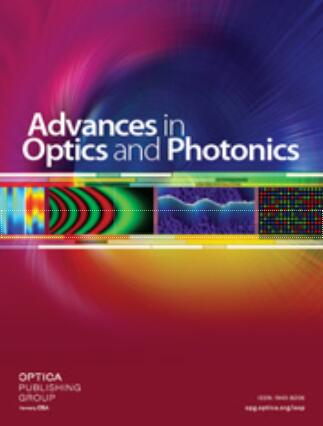Off-axis digital holographic multiplexing for rapid wavefront acquisition and processing
IF 23.8
1区 物理与天体物理
Q1 OPTICS
引用次数: 32
Abstract
Off-axis holographic multiplexing involves capturing several complex wavefronts, each encoded into off-axis holograms with different interference fringe orientations, simultaneously, with a single camera acquisition. Thus, the multiplexed off-axis hologram can capture several wavefronts at once, where each one encodes different information from the sample, using the same number of pixels typically required for acquiring a single conventional off-axis hologram encoding only one sample wavefront. This gives rise to many possible applications, with focus on acquisition of dynamic samples, with hundreds of scientific papers already published in the last decade. These include field-of-view multiplexing, depth-of-field multiplexing, angular perspective multiplexing for tomographic phase microscopy for 3-D refractive index imaging, multiple wavelength multiplexing for multiwavelength phase unwrapping or for spectroscopy, performing super-resolution holographic imaging with synthetic aperture with simultaneous acquisition, holographic imaging of ultrafast events by encoding different temporal events into the parallel channels using laser pulses, measuring the Jones matrix and the birefringence of the sample from a single multiplexed hologram, and measuring several fluorescent microscopy channels and quantitative phase profiles together, among others. Each of the multiplexing techniques opens new perspectives for applying holography to efficiently measure challenging biological and metrological samples. Furthermore, even if the multiplexing is done digitally, off-axis holographic multiplexing is useful for rapid processing of the wavefront, for holographic compression, and for visualization purposes. Although each of these applications typically requires a different optical system or processing, they all share the same theoretical background. We therefore review the theory, various optical systems, applications, and perspectives of the field of off-axis holographic multiplexing, with the goal of stimulating its further development.离轴数字全息复用快速波前采集和处理
离轴全息复用包括捕获几个复杂的波前,每个波前都被编码成具有不同干涉条纹方向的离轴全息图,同时使用单个相机采集。因此,复用离轴全息图可以一次捕获几个波前,其中每个波前编码来自样本的不同信息,使用相同数量的像素通常需要获取一个传统的离轴全息图编码只有一个样本波前。这产生了许多可能的应用,重点是获取动态样本,在过去十年中已经发表了数百篇科学论文。其中包括视场复用、景深复用、用于层析相位显微镜的角度角度复用、用于3-D折射率成像、用于多波长相位展开或光谱学的多波长复用、用于同时采集的合成孔径超分辨率全息成像、利用激光脉冲将不同时间事件编码到平行通道中对超快事件进行全息成像。测量琼斯矩阵和样品的双折射从一个单一的多路复用全息图,并测量几个荧光显微镜通道和定量相位轮廓,在其他中。每一种多路复用技术都为应用全息术有效测量具有挑战性的生物和计量样品开辟了新的视角。此外,即使多路复用是数字化的,离轴全息多路复用对于波前的快速处理、全息压缩和可视化目的是有用的。虽然这些应用通常需要不同的光学系统或处理,但它们都具有相同的理论背景。本文综述了离轴全息复用的理论、各种光学系统、应用和前景,以期促进离轴全息复用的进一步发展。
本文章由计算机程序翻译,如有差异,请以英文原文为准。
求助全文
约1分钟内获得全文
求助全文
来源期刊

Advances in Optics and Photonics
OPTICS-
CiteScore
56.60
自引率
0.00%
发文量
13
期刊介绍:
Advances in Optics and Photonics (AOP) is an all-electronic journal that publishes comprehensive review articles and multimedia tutorials. It is suitable for students, researchers, faculty, business professionals, and engineers interested in optics and photonics. The content of the journal covers advancements in these fields, ranging from fundamental science to engineering applications.
The journal aims to capture the most significant developments in optics and photonics. It achieves this through long review articles and comprehensive tutorials written by prominent and respected authors who are at the forefront of their fields.
The journal goes beyond traditional text-based articles by enhancing the content with multimedia elements, such as animation and video. This multimedia approach helps to enhance the understanding and visualization of complex concepts.
AOP offers dedicated article preparation and peer-review support to assist authors throughout the publication process. This support ensures that the articles meet the journal's standards and are well-received by readers.
Additionally, AOP welcomes comments on published review articles, encouraging further discussions and insights from the scientific community.
In summary, Advances in Optics and Photonics is a comprehensive journal that provides authoritative and accessible content on advancements in optics and photonics. With its diverse range of articles, multimedia enhancements, and dedicated support, AOP serves as a valuable resource for professionals and researchers in these fields.
 求助内容:
求助内容: 应助结果提醒方式:
应助结果提醒方式:


